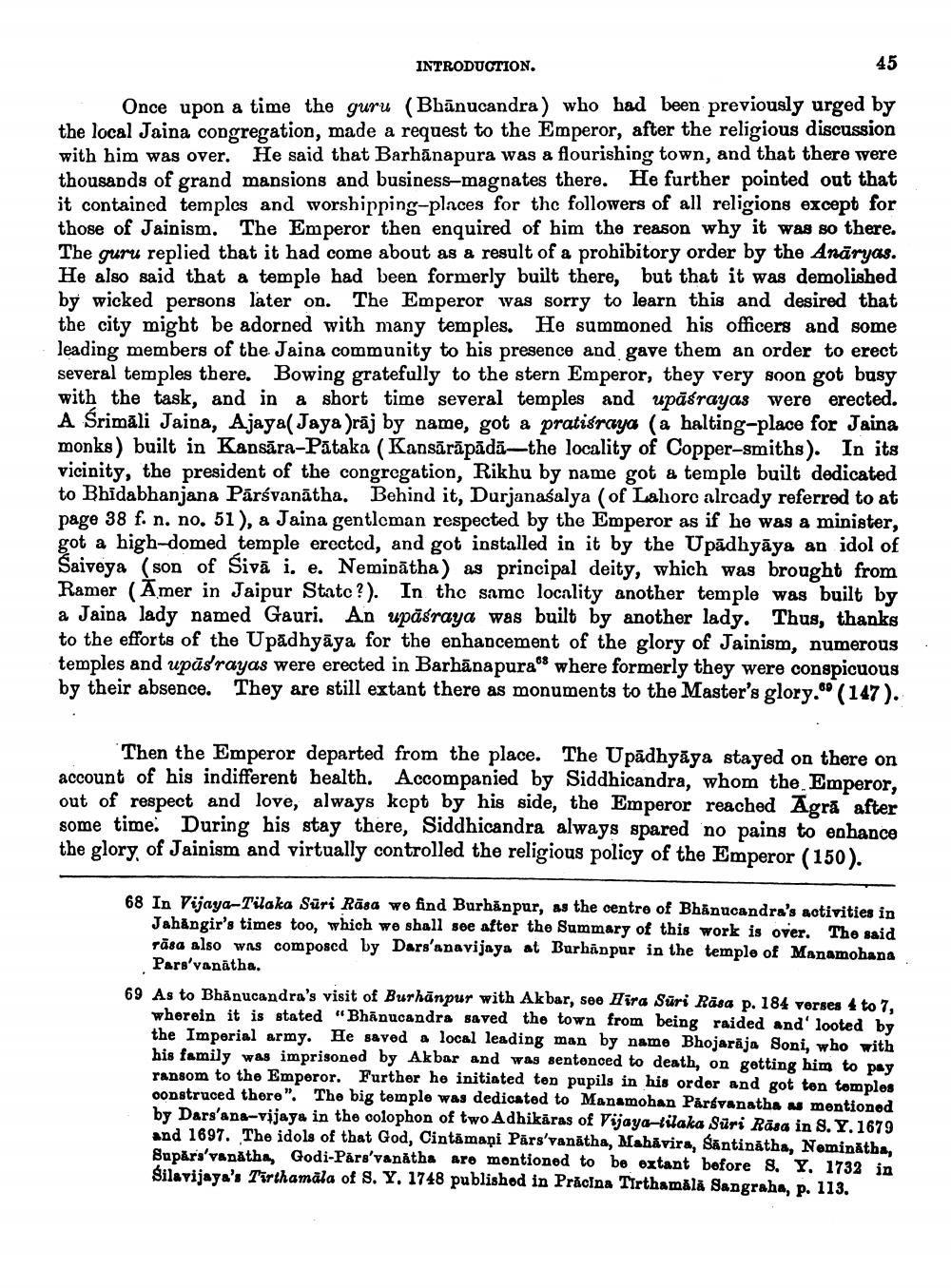________________
INTRODUCTION.
45
Once upon a time the guru (Bbānucandra) who had been previously urged by the local Jaina congregation, made a request to the Emperor, after the religious discussion with him was over. He said that Barhānapura was a flourishing town, and that there were thousands of grand mansions and business-magnates there. He further pointed out that it contained temples and worshipping-places for the followers of all religions except for those of Jainism. The Emperor then enquired of him the reason why it was so there. The guru replied that it had come about as a result of a prohibitory order by the Anāryas. He also said that a temple had been formerly built there, but that it was demolished by wicked persons later on. The Emperor was sorry to learn this and desired that the city might be adorned with many temples. He summoned his officers and some leading members of the Jaina community to his presence and gave them an order to erect several temples there. Bowing gratefully to the stern Emperor, they very soon got busy with the task, and in a short time several temples and upăsrayas were erected. A Srimāli Jaina, Ajaya(Jaya Irāj by name, got a pratisraya (a halting-place for Jaina monks) built in Kansāra-Pătaka (Kansārāpādā—the locality of Copper-smiths). In its vicinity, the president of the congregation, Rikhu by name got a temple built dedicated to Bhidabhanjana Pārsvanātha. Behind it, Durjanaśalya (of Lahore already referred to at page 38 f. n. no. 51 ), a Jaina gentleman respected by the Emperor as if he was a minister, got a high-domed temple erected, and got installed in it by the Upādhyāya an idol of Saiveya son of Sivā i. e. Neminātha) as principal deity, which was brought from Ramer (Amer in Jaipur Stato?). In the same locality another temple was built by a Jaina lady named Gauri. An upäsraya was built by another lady. Thus, thanks to the efforts of the Upadhyāya for the enhancement of the glory of Jainism, numerous temples and upās rayas were erected in Barbānapura” where formerly they were conspicuous by their absence. They are still extant there as monuments to the Master's glory."" (147).
Then the Emperor departed from the place. The Upādhyāya stayed on there on account of his indifferent health. Accompanied by Siddhicandra, whom the Emperor, out of respect and love, always kept by his side, the Emperor reached Agră after some time. During his stay there, Siddhicandra always spared no pains to enhance the glory of Jainism and virtually controlled the religious policy of the Emperor (150).
68 In Vijaya-Tilaka Süri Rāsa we find Burhanpur, as the centre of Bhānucandra's activities in
Jahangir's times too, which we shall see after the Summary of this work is over. The said rāsa also was composed by Dars'anavijaya at Burhanpur in the temple of Manamohana
Pars'vanätha. 69 As to Bhanucandra's visit of Burhanpur with Akbar, see Hira Suri Rāsa p. 184 verses 4 to 7,
wherein it is stated "Bhānucandra saved the town from being raided and looted by the Imperial army. He saved a local leading man by name Bhojarāja Soni, who with his family was imprisoned by Akbar and was sentenced to death, on getting him to pay ransom to the Emperor. Further he initiated ten pupils in his order and got ton tomples construced there". The big temple was dedicated to Manamohan Pårsvanatha mentioned by Dars'ana-vijaya in the colophon of two Adhikäras of Vijaya-bilaka Suri Räsa in S. Y. 1679 and 1697. The idols of that God, Cintamani Pārs'vanátha, Mahavira, Santinătha. Neminātba. Supărs'vanátha, Godi-Pärs'vanātha are montioned to be extant before S. Y. 1732 in Silavijaya's Tirthamala of S. Y. 1748 published in Prācina Tirthamala Sangraha, p. 113.




